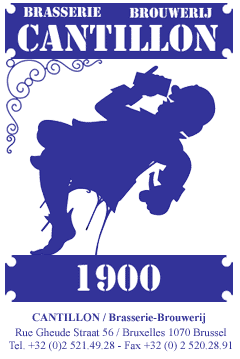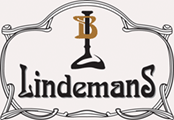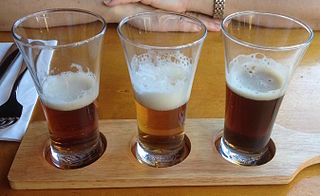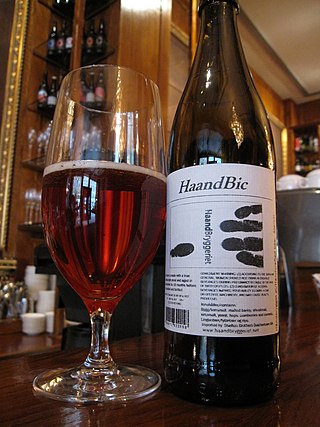
Prunus cerasus is a species of Prunus in the subgenus Cerasus (cherries), native to much of Europe, North Africa and West Asia. It is closely related to the sweet cherry, but has a fruit that is more acidic. Its sour pulp is edible.

Wheat beer is a top-fermented beer which is brewed with a large proportion of wheat relative to the amount of malted barley. The two main varieties are German Weizenbier and Belgian witbier; other types include Lambic, Berliner Weisse, and Gose.

Lambic is a type of beer brewed in the Pajottenland region of Belgium southwest of Brussels and in Brussels itself since the 13th century. Types of lambic beers include gueuze, kriek lambic, and framboise. Lambic differs from most other beers in that it is fermented through exposure to wild yeasts and bacteria native to the Zenne valley, as opposed to exposure to carefully cultivated strains of brewer's yeast. This process gives the beer its distinctive flavour: dry, vinous, and cidery, often with a tart aftertaste.
Big Rock Brewery is a Canadian public company and the largest brewery that is based in Calgary, Alberta, Canada. Additional brewing operations are located in Vancouver, British Columbia; Etobicoke, Ontario; and Liberty Village in Toronto, Ontario. Big Rock distributes a variety of beers and ciders throughout Canada.

Framboise is a Belgian lambic beer fermented with raspberry.

Alken-Maes is a Belgian brewery created out of the 1988 merger of two small breweries, Maes located at Kontich-Waarloos and Cristal-Alken located at Alken. It was bought by Scottish & Newcastle in 2000, who were taken over by Carlsberg and Heineken in 2007.

Brasserie-Brouwerij Cantillon is a small Belgian traditional family brewery based in Anderlecht, Brussels. Cantillon was founded in 1900 and brews exclusively lambic beers.

Fruit beer is beer made with fruit added as an adjunct or flavouring.

Belle-Vue Brewery is a brewery founded in 1913 in Molenbeek, Brussels by Philémon Vandenstock from nearby Itterbeek, which lies in a region known for its lambic type of beer. A variety of Belle-Vue lambic and fruit beers are produced in Sint-Pieters-Leeuw.

Beer in Belgium includes pale ales, lambics, Flemish red ales, sour brown ales, strong ales and stouts. In 2018, there were 304 active breweries in Belgium, including international companies, such as AB InBev, and traditional breweries including Trappist monasteries. On average, Belgians drink 68 litres of beer each year, down from around 200 each year in 1900. Most beers are bought or served in bottles, rather than cans, and almost every beer has its own branded, sometimes uniquely shaped, glass. In 2016, UNESCO inscribed Belgian beer culture on their list of the intangible cultural heritage of humanity.

In brewing, adjuncts are unmalted grains or grain products used in brewing beer which supplement the main mash ingredient. This is often done with the intention of cutting costs, but sometimes also to create an additional feature, such as better foam retention, flavours or nutritional value or additives. Both solid and liquid adjuncts are commonly used.

Brewery Ommegang is a brewery located near Cooperstown, New York, United States, that specializes in Belgian-style ales.

Gueuze is a type of lambic, a Belgian beer. It is made by blending young (1-year-old) and old lambics, which is bottled for a second fermentation. Because the young lambics are not fully fermented, the blended beer contains fermentable sugars, which allow a second fermentation to occur.

Oud Bruin, also known as Flanders Brown, is a style of beer originating from the Flemish region of Belgium. The Dutch name refers to the long aging process, up to a year. It undergoes a secondary fermentation, which takes several weeks to a month, and is followed by bottle aging for several more months. The extended aging allows residual yeast and bacteria to develop a sour flavor characteristic for this style. Usually, cultured yeast and bacteria are used, as stainless steel equipment does not harbor wild organisms as wood does.

Lindemans Brewery is a Belgian family brewery based in Vlezenbeek, a small town in Flemish Brabant, southwestern Brussels. It produces lambics, a style of Belgian ale that uses raw wheat and wild yeast.

Beer styles differentiate and categorise beers by colour, flavour, strength, ingredients, production method, recipe, history, or origin.

Oud Beersel is a Belgian lambic brewery. It is a member of HORAL, whose main event is Toer De Geuze every two years.
The High Council for Artisanal Lambic Beers is a non-profit organisation that brings together the gueuze brewers and blenders of the Pajottenland and Zenne Valley in Belgium.

Sour beer, also known as Sours, is beer which has an intentionally acidic, tart, or sour taste. Traditional sour beer styles include Belgian lambics, gueuze and Flanders red ale, and German gose and Berliner Weisse.

A barrel-aged beer is a beer that has been aged for a period of time in a wooden barrel. Typically, these barrels once housed bourbon, whisky, wine, or, to a lesser extent, brandy, sherry, or port. There is a particular tradition of barrel ageing beer in Belgium, notably of lambic beers. The first bourbon barrel-aged beers were produced in the United States in the early 1990s.



















